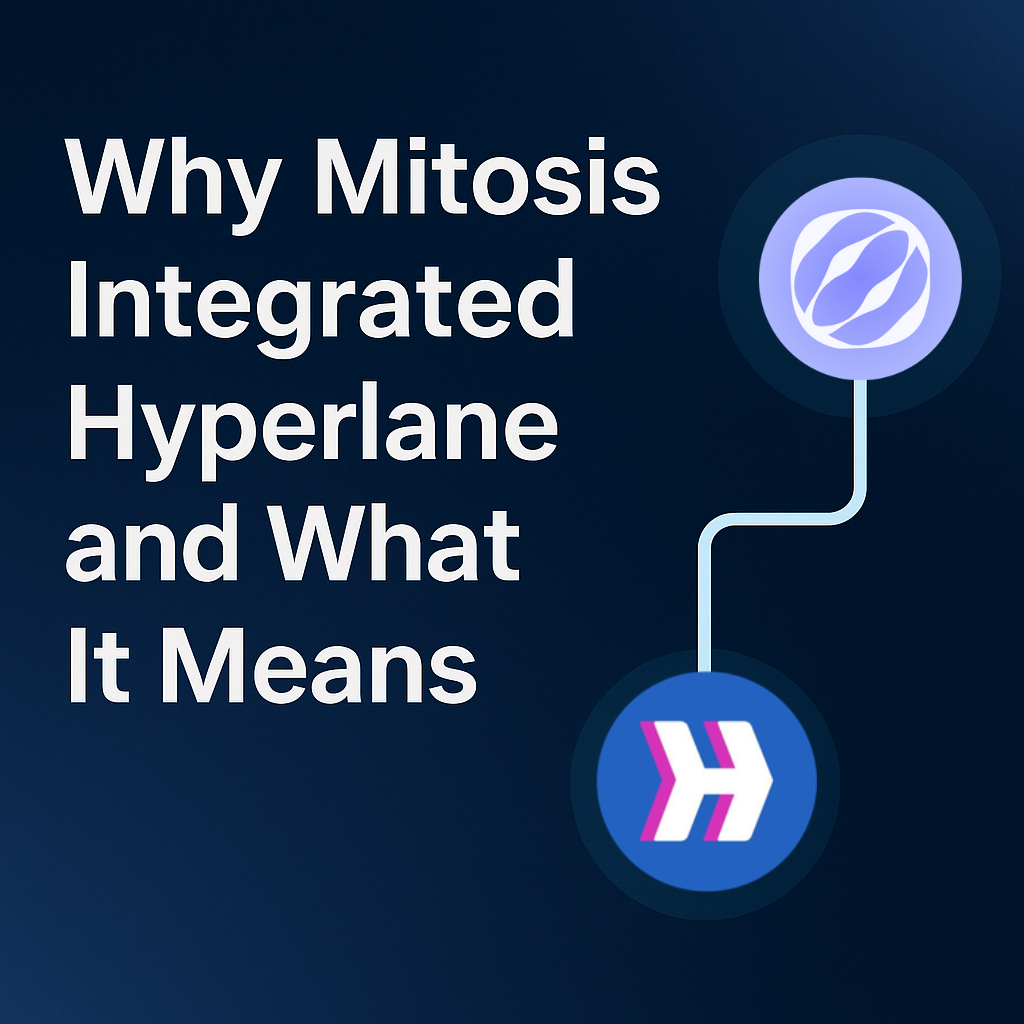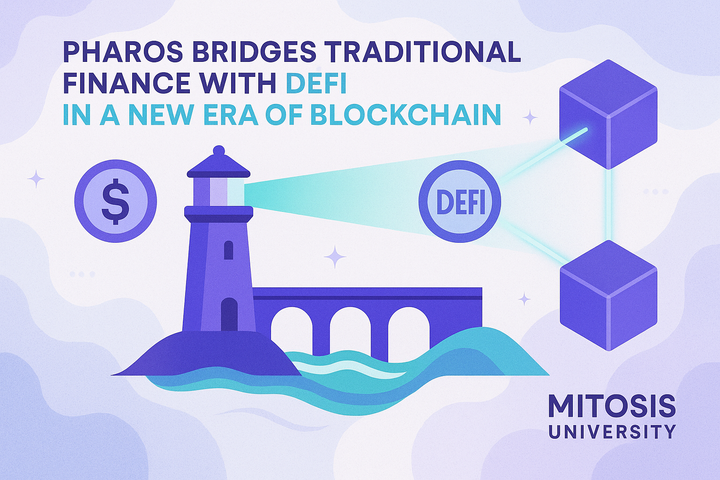Why Mitosis Integrated Hyperlane and What It Means

Decentralized finance (DeFi) thrives on innovation but struggles with fragmentation across its diverse blockchain ecosystems. As of May 2025, DeFi’s total value locked (TVL) exceeds $110 billion, according to DeFiLlama, yet liquidity remains unevenly distributed, Ethereum commands 55% of TVL, while smaller chains like Aptos or Sui face liquidity shortages, leading to high slippage (often over 5% for large trades) and suboptimal yield opportunities. This fragmentation is compounded by the vulnerabilities of cross-chain bridges, with over $2 billion lost to exploits in 2024, per Chainalysis reports.
Mitosis, a modular Layer 1 blockchain, aims to address these challenges by introducing programmable liquidity that operates seamlessly across chains. At the heart of this solution is its integration with Hyperlane, a permissionless interoperability protocol that enables secure, trust-minimized cross-chain communication.
This article explores the rationale, mechanics, and broader implications of this integration for the DeFi ecosystem, positioning Mitosis in a competitive landscape alongside solutions like LayerZero, Axelar, and Chainlink CCIP.
The Rationale Behind Integrating Hyperlane
Mitosis' mission is to transform liquidity into a programmable, composable asset that transcends blockchain boundaries, enabling DeFi protocols to aggregate and deploy liquidity where it’s most needed. This requires a robust interoperability solution that supports real-time, secure, and decentralized communication across diverse networks. Hyperlane stands out as an ideal partner due to its permissionless architecture, which allows any blockchain to integrate without centralized approval (a feature that aligns with Mitosis’s vision of a decentralized, inclusive DeFi landscape).
Hyperlane's lightweight message relayers further its suitability. Unlike traditional cross-chain solutions that rely on centralized multi-signature schemes, Hyperlane employs an optimistic relayer system where validators stake assets to ensure honest message delivery, with disputes resolved on-chain. This reduces centralization risks while maintaining efficiency. Hyperlane’s Interchain Security Modules (ISMs) also allow Mitosis to customize its security model. For example, requiring multiple relayers to confirm high-value transactions, balancing speed with safety.
As of May 2025, Hyperlane supports over 20 chains, including Ethereum, Solana, Cosmos, and newer networks like Monad. Its broad compatibility enables Mitosis to extend its programmable liquidity across the DeFi ecosystem, competing with interoperability protocols like LayerZero, which has facilitated $50 billion in cross-chain volume, and Chainlink CCIP, known for its secure but more centralized oracle-based approach.
Operational Mechanics of the Integration
The Mitosis-Hyperlane integration streamlines cross-chain liquidity operations through a seamless, automated process. When a user deposits tokens into a Mitosis Vault on one chain (e.g., Ethereum), the vault emits an event that Hyperlane’s relayers detect. Hyperlane then securely transmits a cryptographic proof of this lock to a destination chain (e.g., Solana) via its mailbox smart contracts. Upon verification, a Mitosis smart contract on the destination chain mints a corresponding miAsset (a tokenized representation of the deposited asset).
This miAsset can then be used in DeFi protocols on the new chain, such as lending on Aave or trading on a Solana-based DEX. Redemption follows a similar process: burning the miAsset on the destination chain triggers a Hyperlane message to unlock the original tokens on the source chain. This mechanism eliminates the complexity of manual bridging, reducing user friction and mitigating security risks associated with traditional bridges, such as the Wormhole exploit of 2022. Hyperlane’s optimistic verification ensures low latency where messages are assumed valid unless challenged within a dispute window (typically 20 minutes to a few hours, depending on the chain) but introduces a trade-off: fraudulent messages could be relayed if validators collude or are under collateralized.
Mitosis mitigates this by leveraging Hyperlane’s ISMs to enforce stricter confirmation requirements for high-value transactions, ensuring economic security. Gas fees, however, remain a consideration as users may incur costs on both chains for depositing and minting, though Mitosis likely abstracts relayer fees (charged by Hyperlane) to improve the user experience. Hyperlane’s compatibility with major ecosystems like Ethereum, Cosmos, and Solana, as well as emerging chains like Monad, enables Mitosis to deploy its liquidity solutions widely. This broad reach allows users to deposit assets on a low-fee chain like Solana and earn yields on a high-yield chain like Ethereum, all without manual bridging.
Implications for the Broader DeFi Ecosystem
The Mitosis-Hyperlane integration has profound implications for DeFi’s evolution. By enabling programmable liquidity across chains, Mitosis addresses the fragmentation of liquidity pools, enhancing capital efficiency. For example, unified liquidity can reduce slippage in cross-chain trades from 5% (common on smaller chains) to below 1%, per analytics from Uniswap and SushiSwap. This also optimizes yield farming: a user could deposit assets on Solana and earn yields on Ethereum’s Aave market via a miAsset, maximizing returns without the overhead of traditional bridging. In a market where liquidity depth directly impacts profitability, this could unlock billions in additional value for DeFi users. The integration also fosters a more resilient and adaptable DeFi infrastructure.
Hyperlane’s permissionless nature allows Mitosis to integrate with emerging blockchains rapidly, deploying mailboxes on new networks like Monad without centralized bottlenecks. This adaptability positions Mitosis as a pivotal player in DeFi’s push toward a more interconnected ecosystem, competing with solutions like Axelar, which focuses on universal messaging, and LayerZero, which emphasizes lightweight bridging. However, security remains a concern. Hyperlane’s economic security model, while flexible, relies on validator incentives. If under collateralized, relayers could relay fraudulent messages, leading to miAsset minting errors. Mitosis’s use of ISMs mitigates this, but it’s less centralized than Chainlink CCIP’s oracle-based approach, which prioritizes security over (a trade-off that developers and users must weigh).
Conclusion
The strategic integration of Hyperlane into Mitosis’s architecture marks a significant milestone in DeFi’s pursuit of unified, programmable liquidity. By leveraging Hyperlane’s permissionless interoperability, Mitosis transcends traditional liquidity constraints, enabling seamless asset movement and interaction across diverse blockchain networks. This enhances capital efficiency (reducing slippage, optimizing yields, and unlocking new opportunities for users) while setting a precedent for cross-chain DeFi solutions. Looking ahead, the principles of permissionless interoperability and programmable liquidity could shape the next generation of DeFi applications.
Cross-chain automated market makers (AMMs) that dynamically adjust fees based on liquidity depth, or cross-chain derivatives allowing users to hedge positions across ecosystems, are just a few possibilities. As Mitosis and Hyperlane lay the groundwork for a more cohesive and dynamic DeFi ecosystem, they not only address current pain points but also pave the way for a future where liquidity flows freely across chains, unlocking the full potential of decentralized finance.



Comments ()